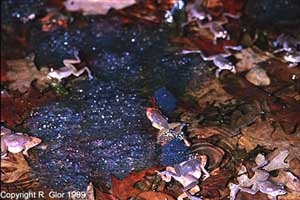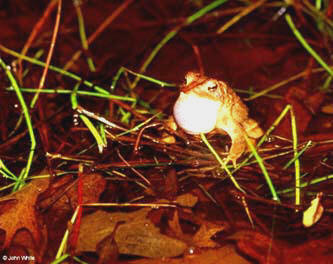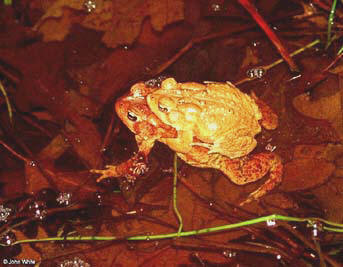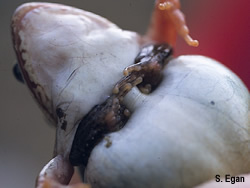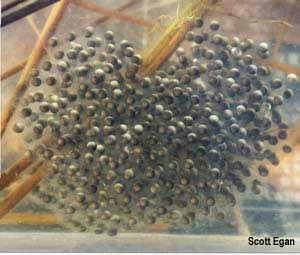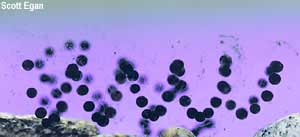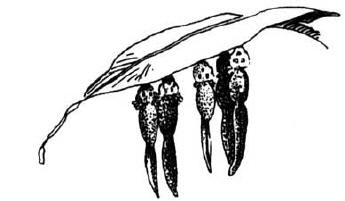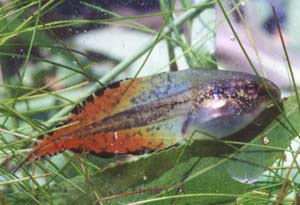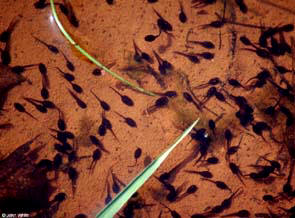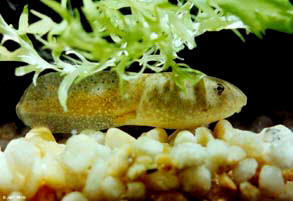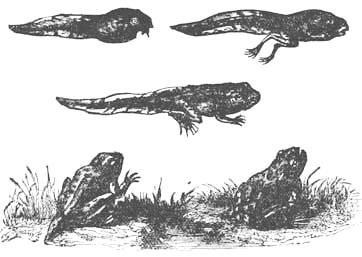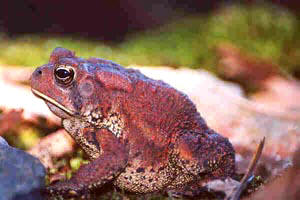|
The Anuran Life Cycle |
|
|
Photo by Rich Glor Wood Frogs Rana sylvatica
|
Photo by Rich Glor Wood Frogs and Eggs
|
|
|
|
The Anuran Life Cycle
|
|
|
Male frogs gather at the breeding pools and begin to vocalize (call) to attract females. Females arrive at the breeding sites and seek out the most attractive males. Those males with the deepest voices and the longest calls attract the most females. Larger frogs have deeper voices and those frogs that are the largest and have the longest calls are the most fit. |
Photo by John White A male American toad, Bufo americanus, calling to attract female toads.
|
|
|
|
|
Photo by John White American toads, Bufo americanus, in amplexus. The male is on top and the larger female is below.
|
A male grasps a female from behind and grips her behind her front legs and hangs on until mating is completed (amplexus). During amplexus, the female expels her eggs and the male releases sperm into the water to fertilize them. This type of fertilization is called external fertilization. |
|
|
|
|
Photo by Scott Egan, University of Rhode Island Dept. of Natural Resources A pair of wood frogs, Rana sylvatica, in amplexus. The female is the larger individual on the bottom. Many males will often try to mate at once with a single breeding female, creating large stacks of frogs.
|
Photo by Scott Egan, University of Rhode Island Dept. of Natural Resources Once a male grasps onto a female it is difficult to get him to let loose. This helps to insure that he will be the one to breed with the female and pass his genes onto the next generation.
|
|
|
|
|
The eggs are laid in jelly-like masses in groups of a few to as many as several hundred depending upon the species. The egg cells of each embryo begin to divide into more cells (egg cell cleavage) and grow to form the tadpole. The eggs hatch within a few days. |
Photo by John White Tennessee's toads, like the American toads pictured above, lay their eggs in spiral strands.
|
|
Photo by Scott Egan, University of Rhode Island Dept. of Natural Resources Most of Tennessee's frogs lay their eggs in clumps, like this clump of eggs from a pickerel frog, Rana palustris.
|
Photo by Scott Egan, University of Rhode Island Dept. of Natural Resources The two toad species that occur in Tennessee, the American (Bufo americanus) and the Fowler's (Bufo fowleri ) toad, lay their eggs in a spiral strand. |
|
|
|
|
After hatching the tadpoles cling to surrounding vegetation or the egg mass until they reach the free swimming stage. They do not eat at this time but rely on their yolk reserves.
|
Photo by Scott Egan, University of Rhode Island Dept. of Natural Resources Tadpoles of the gray treefrog and Cope's gray treefrog are very colorful. Most species of tadpole are difficult to identify and require sedating the tadpole to examine the minute teeth in its' mouth used for grazing algae.
|
| Tadpoles remain in the water a few weeks for most species, and up to 2 years for other species, before they metamorphose. Metamorphosis is the process in which a tadpole changes into a frog.
|
|
|
Photo by John White American toad tadpoles, Bufo americanus, mature quickly as the temporary pools where they lay their eggs may dry up quickly.
|
Photo by John White American bullfrog tadpoles, Rana catesbeiana, may take as long as 2 years to metamorphose, especially in colder climates.
|
|
Metamorphosis
|
|
| Metamorphosis is a complex series of changes both external and internal. Lungs are formed, gills are absorbed, the digestive system changes from a primarily vegetarian one to a carnivorous one, legs appear and the tail is absorbed. These are only a few of the miraculous changes a tadpole undergoes on its way to becoming a frog or toad.
|
|
|
Photo by Charlie Freeman, TWRA A beautiful red phase American toad, Bufo americanus.
|
Photo by Joyce Gross A lovely tan phase American toad, Bufo americanus.
|
| Once metamorphosis is complete, the frog or toad leaves the water to live a mostly terrestrial life, returning to the water to breed and produce the next generation of tadpoles. |
|
|
For more information about frogs and toads check out:
Introduction to the
Anura
List of
Scientific Names ||
Amphibian Declines
Updated March 22, 2002 |
|

